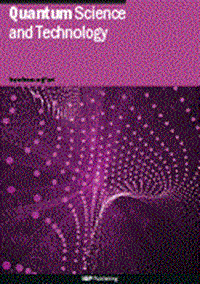Single photon coherent Ising machines for constrained optimization problems
IF 5
2区 物理与天体物理
Q1 PHYSICS, MULTIDISCIPLINARY
引用次数: 0
Abstract
A Coherent Ising machine (CIM) is an oscillator-network-based analog computing system to circumvent the bottleneck in von Neumann digital computing architectures. The CIM consists of a network of degenerate optical parametric oscillators (DOPOs) and is designed to find a ground state or perform Boltzmann sampling for all degenerate ground states and low-energy excited states in combinatorial optimization problems. A nonlinear measurement feedback scheme, called chaotic amplitude control (CAC), has recently been proposed to correct pulse amplitude inhomogeneity and thereby faithfully map the Ising Hamiltonian to the loss landscape of the DOPO network. However, the quantum limit of the CIM-CAC performance is not fully explored yet. This work clarifies how the quantum noise squeezing and the measurement-induced state shift in repeated indirect quantum measurements improve the system performance. From the numerical simulation on the Ising model with the Zeeman terms, obtained from combinatorial clustering problems formulated as constrained optimization problems, it is revealed that the CIM-CAC operating in a single photon per pulse regime dramatically outperforms the standard CIM-CAC with a large photon number per pulse. This is because the standard CIM-CAC is often trapped in a periodic trajectory and cannot escape from there. On the other hand, the significant improvement is brought by the noise-induced amplitude jump in the single photon CIM-CAC.约束优化问题的单光子相干伊辛机
相干伊辛机(CIM)是一种基于振荡器网络的模拟计算系统,旨在克服冯·诺依曼数字计算体系结构的瓶颈。CIM由简并光学参量振荡器(DOPOs)组成,用于组合优化问题中寻找基态或对所有简并基态和低能激发态进行玻尔兹曼采样。最近提出了一种非线性测量反馈方案,称为混沌幅度控制(CAC),用于校正脉冲幅度的不均匀性,从而将伊辛哈密顿量忠实地映射到DOPO网络的损失情况。然而,CIM-CAC性能的量子极限尚未被充分探索。本文阐明了重复间接量子测量中量子噪声压缩和测量引起的态移如何改善系统性能。通过将组合聚类问题表述为约束优化问题的Ising模型与Zeeman项进行数值模拟,揭示了在单光子/脉冲状态下运行的CIM-CAC显著优于在大光子/脉冲状态下运行的标准CIM-CAC。这是因为标准的CIM-CAC经常被困在周期性轨迹中,无法从中逃脱。另一方面,在单光子CIM-CAC中,噪声引起的幅度跳变带来了显著的改善。
本文章由计算机程序翻译,如有差异,请以英文原文为准。
求助全文
约1分钟内获得全文
求助全文
来源期刊

Quantum Science and Technology
Materials Science-Materials Science (miscellaneous)
CiteScore
11.20
自引率
3.00%
发文量
133
期刊介绍:
Driven by advances in technology and experimental capability, the last decade has seen the emergence of quantum technology: a new praxis for controlling the quantum world. It is now possible to engineer complex, multi-component systems that merge the once distinct fields of quantum optics and condensed matter physics.
Quantum Science and Technology is a new multidisciplinary, electronic-only journal, devoted to publishing research of the highest quality and impact covering theoretical and experimental advances in the fundamental science and application of all quantum-enabled technologies.
 求助内容:
求助内容: 应助结果提醒方式:
应助结果提醒方式:


